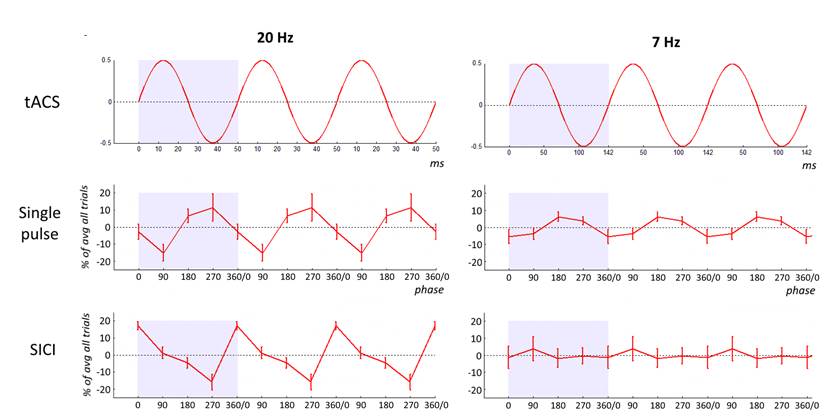Phase Dependency of the Human Primary Motor Cortex and Cholinergic Inhibition Cancelation During Beta tACS.
Some brain circuits have particular resonances, like different keys on a keyboard. Here, we show in humans that the special resonance of a part of the brain called the motor cortex involves a particular type of nerve cell that uses a chemical messenger called GABA. We also show a link between this resonance and how messages from sense organs modulate movement.
The human motor cortex has a tendency to resonant activity at about 20 Hz so stimulation should more readily entrain neuronal populations at this frequency. We investigated whether and how different interneuronal circuits contribute to such resonance by using transcranial magnetic stimulation (TMS) during transcranial alternating current stimulation (tACS) at motor (20 Hz) and a nonmotor resonance frequency (7 Hz). We tested different TMS interneuronal protocols and triggered TMS pulses at different tACS phases. The effect of cholinergic short-latency afferent inhibition (SAI) was abolished by 20 Hz tACS, linking cortical beta activity to sensorimotor integration. However, this effect occurred regardless of the tACS phase. In contrast, 20 Hz tACS selectively modulated MEP size according to the phase of tACS during single pulse, GABAAergic short-interval intracortical inhibition (SICI) and glutamatergic intracortical facilitation (ICF). For SICI this phase effect was more marked during 20 Hz stimulation. Phase modulation of SICI also depended on whether or not spontaneous beta activity occurred at ~20 Hz, supporting an interaction effect between tACS and underlying circuit resonances. The present study provides in vivo evidence linking cortical beta activity to sensorimotor integration, and for beta oscillations in motor cortex being promoted by resonance in GABAAergic interneuronal circuits.

2016.Cereb. Cortex, 26(10):3977-90.
2024. Nat Metab, 6(11):2100-2117.